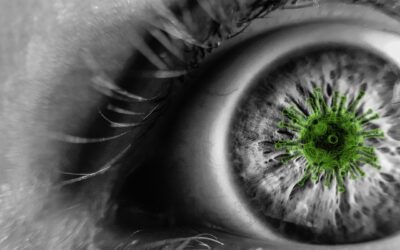While uncommon in the United States, the worldwide number one cause of preventable blindness is from a disease called Trachoma.
Chlamydia Trachomatis
Trachoma is a bilateral (involving both eyes) eye infection caused by the bacterium Chlamydia trachomatis, which is also responsible for the more well–known sexually transmitted disease—chlamydia.
Trachoma, however, does not affect the genital region. Trachoma is a disease strictly of the eyes.
More specifically, chlamydia trachomatis serotypes A, B and C cause Trachoma, whereas Chlamydia trachomatis serotypes D, E, F, G, H, I, J and K cause the STD Chlamydia infection.
Trachoma is more commonly seen in third world countries, or areas of poverty or poor sanitation.
Trachoma is very contagious. It spreads directly through personal contact between an infected individual’s eye, nose, or throat discharge to another person.
Most commonly, it is transmitted through a secondary pathway such as sharing bedding, wash cloths, clothing, or by bot flies who regularly feed on mucous and discharge of individuals living in areas of poor hygiene.
Initial infection is often seen in the adolescent years. Repeated infection over many years causes scarring leading to eventual vision loss and blindness.
Eye Anatomy
To best understand how Trachoma infections progress to blindness, it is best to have some idea of the eye’s anatomy.
The eye has many different inter-working parts.
The front most, clear structure of the eye is called the cornea. It contains many nerves and is therefore sensitive to pain and irritation.
The cornea is the first surface responsible for refracting light rays to make them focus on the retina—the back most structure of the eye.
The retina contains special cells called photoreceptors. Photoreceptors detect light and then transmit signals to the brain for image processing.
What makes the eye all the more complex is that it moves almost constantly—it rotates torsionally clockwise and counter-clockwise, up, down, left, and right. We also blink multiple times a minute—without lubrication the eyelids would shear off the superficial cornea causing serve pain and decreased vision!
Due to this constant movement, the eye needs to stay lubricated to decrease friction. Friction in the eye is a bad thing as the structures of the eye are relatively delicate and a prone to scratches, scrapes, cuts, and bruises.
To help cushion the eye and make it more friction-resistant, it is covered by a lining called the conjunctiva. The conjunctiva has two major purposes—act as a squishy, flexible barrier, allowing for eye movement, as well as being a protective barrier against foreign material like dust, dirt, and bacteria.
The conjunctiva covers the sclera (the white part of the eye) and the inner eyelids. It contains special mucous producing cells called goblet cells, which help to keep the eye lubricated as well as having antimicrobial properties to help fight off infections.
Cause of the Trachoma
Trachoma is a disease in which the bacteria infect the conjunctiva, also known as a conjunctivitis.
As mentioned above, the conjunctiva lines the eyelids in addition to the sclera. Therefore, essentially the entire outer coating of the eye will feel inflamed and irritated.
An initial infection may be rather minor. The eyes will be irritated, painful, and may be pink or red in color—similar to the presentation of a typical pink eye.
Over time, however, constant inflammation from exacerbations and recurrences of the infection can lead to scarring.
When the inner eyelids scar, it makes them less flexible and the lids begin to bunch up, turning inward so that the eyelashes no longer sit perpendicular to the eye, but instead curl down into the eye.
The inward curling of the eyelids is called entropion. Misdirected growth of eyelashes so that they brush up against the eye itself is called trichiasis.
Eyelashes are made to keep foreign materials out of the eye. When they are turned inward so that they make contact with the eye, the lashes scrape and scratch the cornea. This causes irritation, pain, secondary infection, and eventually, more scarring.
Scarring of the cornea secondary to trichiasis however is more severe than scarring of the eyelids, as now there is scarring on the eye itself, blocking the transmission of light or altering how it is refracted to the retina.
If scarring continues to worsen, it can eventually cause opacification of the entire cornea, resulting in the inability for light to pass into the eye. When no light reaches the retina, no light is detected and no image is formed. At this point, the individual is considered blind.
How is Trachoma Treated?
Ultimately, to treat Trachoma we want to reduce the amount of inflammation and scarring.
In early stages, this can be accomplished with antibiotics.
If the disease progresses to the entropion stage, surgery may be necessary to reshape the eyelid to keep it from rubbing against the cornea. Epilation (surgical removal) of the eyelashes may also be necessary to help prevent friction on the cornea.
Very frequent lubrication of the eye with thick artificial tears, gels, and ointments may also be beneficial to these individuals to create an artificial cushion between the lids and the cornea.
In the latest stages of the disease, a cornea transplant may be beneficial to help recover some vision.
Unfortunately, the areas most affected by Trachoma tend to have limited access to healthcare—hence why Trachoma is the leading cause of preventable blindness worldwide.





